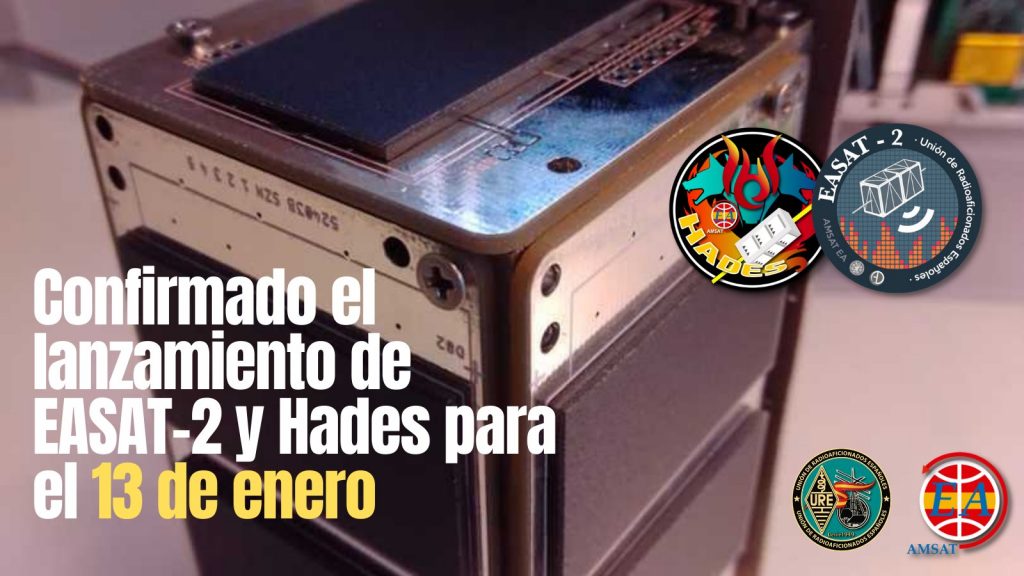 AMSAT-EA Mission Manager Felix EA4GQS provides an update on the status of the EASAT-2 and HADES satellites launched on January 13.
AMSAT-EA Mission Manager Felix EA4GQS provides an update on the status of the EASAT-2 and HADES satellites launched on January 13.
On the AMSAT Bulletin Board he writes:
We confirm the reception of both EASAT-2 and HADES, as well as the decoding of telemetry and the FM recorded voice beacon with the callsign AM5SAT of the first one. EASAT-2 appears to be working well except for the deployment of the antennas, something that apparently has not yet occurred and causes weak signals. However, the AMSAT-EA team confirms that, based on the reception of FSK, CW, the FM voice beacon and the telemetry data that has been decoded, it can be said that the satellite is working perfectly. In the event of low battery or system malfunction, the on-board computer would not transmit CW messages or the voice beacon-callsign, as it would be in a ‘safe’ state with only fast and slow telemetry transmissions.
These signals that have been able to confirm the operation of both satellites were received by Dr. Daniel Estévez EA4GPZ at 18:07 UTC on Saturday, January 15, using two antennas from the Allen Telescope Array. The TLEs used were obtained from the radio amateur community, with Doppler observations from the Delfi-PQ satellite, deployed together with EASAT-2 and Hades.
TLEs used were these ones:
https://github.com/AMSAT-EA/easat2-tle-lottery/blob/main/satnogs-2022-01-16-DELFI-PQ.tle
Daniel EA4GPZ performed a preliminary analysis using just one polarization of one of the satellite dishes. EASAT-2 has been detected with a relatively strong signal, close to the Delfi-PQ signal, obtaining said recorded voice FM beacon transmissions and FSK, FSK-CW at 50 baud.
The CW beacon clearly shows the message: VVV AM5SAT SOL Y PLAYA, which is one of several that both satellites emit, although the callsign AM5SAT confirms that it is EASAT-2.
In the recording made by Daniel EA4GPZ there is also a faint trace confirmed to be from Hades and stronger packets probably from the IRIS-A satellite.
HADES, like EASAT-2, is transmitting weak signals, weaker than the ones of EASAT-2, most likely because the on-board computer has not yet managed to deploy the antennas either, although it will continue trying regularly. The reason the signals are suspected to be weaker at Hades is that the antennas are more tightly folded than those of EASAT-2. In any case, this is great news, since the transmission pattern confirms the proper functioning of the satellite. In the observations you can see the FSK tones with a deviation of about 5 kHz interspersed with the FM carrier corresponding to the voice beacon of the satellite, which has callsign AM6SAT. The AMSAT-EA team is working to try to decode the telemetry signals and obtain more detailed information on the state of the satellite.
We kindly ask you, if you have very high gain antennas, to try to receive them, specially Hades. If we could decode telemetry it would be very helpful for us.
Until antennas are deployed it will be very difficult to use their repeaters or to receive any SSTV camera images from Hades, but we hope that this will happen sooner or later, at least because even if the computer doesn’t succeed applying heat to the resistor where the thread is attached, with time, the thread should break due to the space environment conditions.
Details of the decoded telemetry and voice, as well as more details in:
https://www.amsat-ea.org/ (Texts are in Spanish)
And in the following Twitter threads:
EASAT-2 transmissions:
https://twitter.com/ea4gpz/status/1482457631566487553
EASAT-2 decodings by Gabriel Otero:
https://twitter.com/gaoterop/status/1482758196037050382
HADES transmissions:
https://twitter.com/ea4gpz/status/1482696274797338625
Thanks a lot and 73,
Felix EA4GQS – AMSAT EA Mission manager
